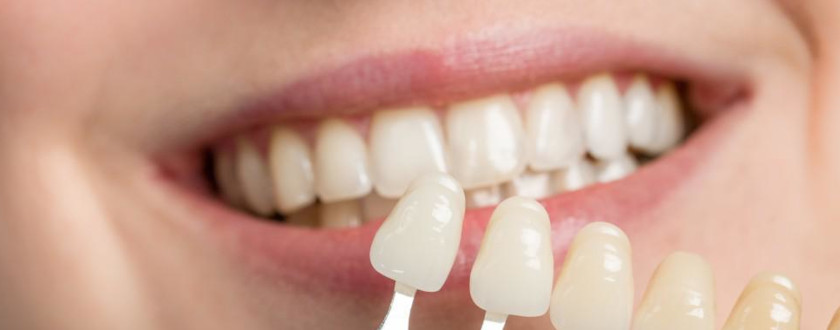
Dental Porcelain Veneers
Dental Porcelain Veneers
Dental porcelain veneers are thin layers of ceramic that can be used to create natural-looking dental restorations. Porcelain veneers have become popular in recent years because they can solve a variety of dental issues. Patients who wish to achieve a more beautiful smile can use porcelain veneers to change the position, shape, size, and color of their teeth.
Why choose porcelain veneers?
Dental porcelain veneers are stain resistant and natural looking. They require a minimal amount of tooth reduction and can be used to fix a variety of aesthetic abnormalities, including:
- Discoloration due to root canal therapy, medications, excessive fluoride, or stained composite resin fillings.
- Chipped, broken, or worn down teeth.
- Misaligned, uneven, or irregularly shaped teeth.
- Teeth with spaces between them.
Am I a good candidate for porcelain veneers?
To determine if you're a good candidate for porcelain veneers, schedule a consultation with your dentist. You must have healthy teeth and gums to qualify for porcelain veneers.
Your dentist will need to remove a layer of enamel before attaching the porcelain. This procedure is irreversible. While veneers can last up to 10 years, they will eventually need to be replaced. Carefully consider your options before electing to undergo the procedure.
The only way to determine if you're a good candidate for veneers is to consult a cosmetic dentist. After evaluating your dental history and current oral health, your dentist can help you make an informed decision.
How are porcelain veneers attached?
After the initial consultation, the dental veneer procedure can usually be completed in two office visits. To begin, your dentist may administer a local anesthetic before reducing the enamel. The amount of tooth enamel removed will vary in each case, but it’s typically 0.5 to 0.7 millimeters.
Next, your dentist will take an impression of your teeth that will be sent to a dental laboratory. The turnaround time for porcelain veneers is typically 1 to 2 weeks. In the meantime, your dentist may fit you with a temporary veneer.
When you return for the second visit, your dentist will remove the temporary veneer and clean the surface of your tooth. Next, the veneer will be bonded to your teeth using special cement. Once the veneer is securely attached, your dentist can remove the excess cement and trim the veneer as needed.
You will usually need to return for a follow-up appointment in 1 to 2 weeks. At that time, your dentist will examine your bite and evaluate your gums to see how they are responding to the presence of a veneer.
Does porcelain veneer placement hurt?
Porcelain veneer placement doesn't typically cause pain. You dentist may use a local anesthetic while reducing the enamel. The attachment process doesn’t usually involve any discomfort. Some patients with new veneers experience increased sensitivity that disappears after several weeks.
How many porcelain veneers should I get?
Porcelain veneers are meant to enhance your smile. The number of veneers you need depends on how wide your smile is. Most people show 6 to 12 teeth when they smile. On the other hand, patients who wish to fix a single chipped tooth will only need one veneer. Choose the number of veneers based on your cosmetic goals and budget.
How do I care for my porcelain veneers?
Porcelain veneers are very durable. With proper care, they can last 10 years or more. While porcelain veneers are stain resistant, it’s best to avoid highly pigmented foods and beverages. If you drink coffee, tea, or red wine, try to brush your teeth immediately afterwards.
Porcelain veneers are more delicate than your natural teeth. To prevent unnecessary damage, avoid chewing hard items. If you grind your teeth at night, your dentist can fit you with a night guard that will protect your veneers from chips and fractures.
If you have porcelain veneers, it's important to schedule regular dental checkups. Brush your teeth and floss at least twice per day in between professional cleanings. Your dentist can help you develop an effective oral health care plan that will keep your veneers looking their best.